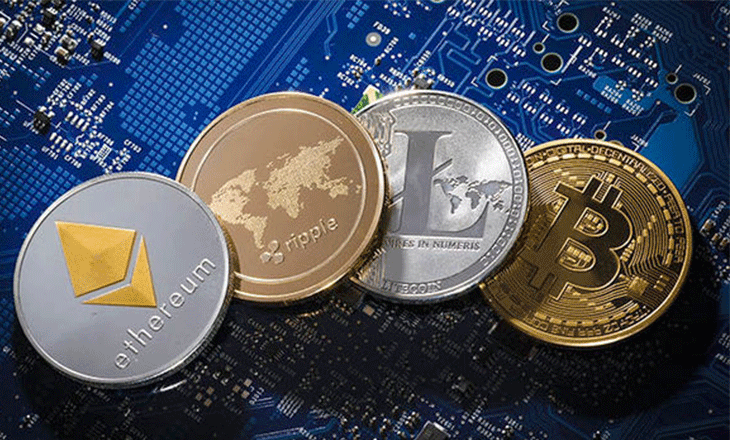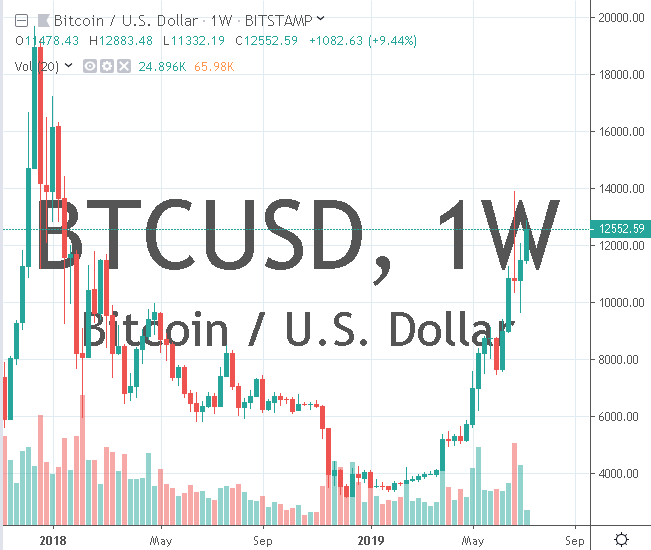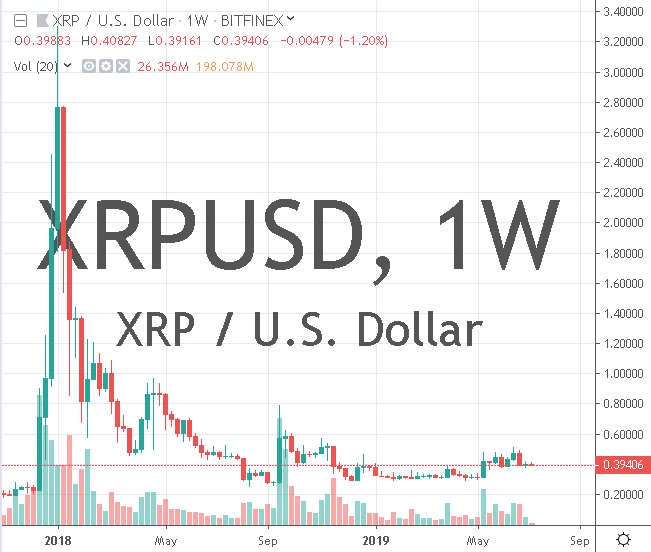While Bitcoin may dominate the cryptocurrency headline space, there are definitely many other coin programs in the Crypto-verse that might command your attention from time to time, if not for investment purposes, then for their “use cases” in the world of blockchain innovation. According to Coinmarketcap.com, there are over 2,300 token programs at last count, many of which have never been listed on an exchange and are considered high risk, as are most other crypto investments. The mainstays at the top include household names like Ethereum, Ripple, and Litecoin, all of which are well-established programs in the crypto space.
As of this writing, the market capitalization of all coin programs is roughly $345 billion. The four token programs noted above comprise 80.4% of that figure, with Bitcoin the obvious market leader at 63.5%. Here is a brief summary:
- Bitcoin (BTC) MC = $220.6 billion or 63.5%
- Ethereum (ETH) MC = $33.1 billion or 9.7%
- Ripple (XRP) MC = $16.8 billion or 5.0%
- Litecoin (LTC) MC = $7.5 billion or 2.2%
Bitcoin’s meteoric rise in value during 2019 has also dominated press headlines, but one of these contenders has actually fared better over the same period. Token programs other than BTC have generally been lumped together and called “altcoins”. Although Bitcoin’s market share has increased over the past year from 40% to 63.5%, altcoins have typically rallied whenever Bitcoin has pulled back from a recent run up, a sign that investors’ tolerance for risk has increased.
Of late, however, the highly anticipated altcoin rally has not occurred as expected. Yes, some programs have vaulted forward, while others have lagged, an indication that investors are more deliberate in picking winners and losers. A recent report from Binance Research has also indicated that this correlation between Bitcoin and altcoins is on the decline. Second quarter data reflected a correlation coefficient of 0.61, as opposed to a 0.73 figure for the first quarter. Analysts attribute this drop to a supposed “culling of the herd”, as the market evaluates various “use cases” in a survival of the fittest scenario.
Investing and trading in cryptocurrencies is an extremely high risk endeavor, an indication that more due diligence, more training, and more practice trading are given prerequisites for any chance at success in this asset class, known to be the most volatile asset class in history. The industry peaked in early 2018, followed by a drop in value of from 80% for the top names to 90% and more for other tokens, a period known as “Crypto Winter”. There have been several offerings, whose value has been beaten down recently, one good reason to avoid these programs. The market beat those values down for a reason. Generally speaking, the “Top 10” programs offer more stability, but the four programs that will be reviewed here are at the top of the heap.
Will Bitcoin and its altcoin brethren climb to higher heights? Like every other investment medium, the correct answer could be “yes” and it could be “no”. Granted, there is a high level of optimism, some would say exuberance, in the Crypto-verse at the moment. BTC has risen from a bottom of $3,130 in late December to be targeting $13,000 as of now, an almost unheard of multiple in so short a time period of “4X”, roughly a 300% gain. A large portion of the analyst community expects a major correction at this stage, but Bitcoin has been beating its own drummer, oblivious of the opinions of others.
No one, not even the most well respected analyst in town, knows exactly what will happen next in the cryptocurrency world. The industry is still in its nascent stage of development. Anything could transpire, but awareness is always a good thing. A brief overview of the four programs listed above follows.
Bitcoin – “BTCUSD”
Let’s start with “Numero Uno”, Bitcoin. It was originally designed as a decentralized currency that did not require banks or a central bank to function. At its core, blockchain technology enabled this value exchange to occur at the point of sale, but early zealots believed the token would represent a “store of value” immune to the dilution that occurs regularly with fiat currencies. The latter “use case” has supplanted the retail usage component, and speculators have driven the value of “Digital Gold” skyward.
The bellwether for all crypto offerings has been on a tear this year, displaying a remarkable pace that many have called “parabolic”. Its meteoric rise has resembled in many ways the path it chose in 2017, when speculation mania gripped the market, creating an “asset bubble” that could not be sustained. Many claim this year is different, since there are a multitude of fundamental drivers, including institutional interest, which had primarily been absent two years back.
Although the crypto-sphere has no ownership rights to blockchain technology, the entire investment group does benefit when awareness of blockchain innovations hit the press. Forbes released a new “Top 50” list that revealed that global corporations have adopted the technology as their own, with a multitude of product applications that increase efficiency, while reducing costs at the same time. Large companies like Facebook, IBM, and JPMorgan Chase have also created industry hype. Fidelity, TD Ameritrade, and eTrade have also designed platforms that appeal to both retail and institutional investors, while projects like Bakkt, ErisX, Seed CX, and LedgerX promote futures hedging tools.
Analysts claim that the convergence of so many good things in the marketplace is the real reason for Bitcoin’s rocket-like performance. The chart certainly says it all, with volumes improving with each passing month. There have been surprising bumps, but no major correction during this bull-run. The current narrative is split between predicting a 30%+ correction as a necessary condition for future appreciation to overly enthusiastic forecasts that BTC will set new All-Time-Highs in 2020. The slope of recent pricing behavior can hardly be described as sustainable. Gravity has a way of appearing unexpectedly in times like these, but Bitcoin has surprised more often than not.
Ethereum – “ETHUSD”
Ethereum was the brainchild of Vitalik Buterin, a cryptocurrency researcher and programmer. It came to life in July of 2015 after a crowd-funding exercise sold 72 million of its tokens, labeled “Ether” or “ETH”. Ethereum has been called a “Do-it-Yourself platform for developing uses of smart contracts that will work in decentralized situations. Ether is then the “vehicle” for running the various apps, or “Dapps” in crypto lingo.
The currency aspect of the blockchain is but one application enabled by the technology. Developers quickly fastened onto Ethereum’s platform, as a standard basis for creating a myriad of other applications. Its coding language is known as “Solidify”, which is used to create smart contacts that can execute in a decentralized environment. These contracts control the typical aspects of enforcement, management, performance, and payment, all through the logic code of the Dapp. In 2016, the system split via a “hard fork” to become Ethereum (ETH) and Ethereum Classic (ETC) to reverse a theft.
The chart for ETH looks similar to the one for Bitcoin from a form perspective, but not nearly as dramatic. Ether formed a bottom in late December of 2018, as well, and has appreciated more than 200% from that point, not nearly as much as Bitcoin has. It also has much further to go to reach its All-Time-High, but stability does have value. You may not see a “parabolic” shape, but prices are moving north at a considerable clip.
Ripple – “XRPUSD”
By definition: “Ripple (XRP) is a peer-to-peer powered cryptocurrency designed to work seamlessly with the Internet to allow a fast, direct and secure way to send payments on the web.” Ripple is, perhaps, better known for its digital payment protocol and its potential usage in the global real time gross settlements (RTGS), exchange and money transfer system. It can enable the seamless transfer of any form of fiat currency, whether it be the U.S. Dollar, Yen, or any other form of money, like Bitcoin or Litecoin.
Brad Garlinghouse, the ebullient and outspoken CEO of San Francisco’s Ripple Labs Inc., has chastised the current cross-border payment industry and its lead facilitator, the S.W.I.F.T. organization. He has repeatedly claimed in public that his firm will “leapfrog Swift’s 1970s-conceived system with a faster, cheaper blockchain-like one”. His firm has over one hundred banks in its network, although none of them are major, top-tier banking entities.
A quick review of Ripple’s chart reflects a similar parabolic rise in 2017, followed by a major collapse in 2018, but it does not show a corresponding sharp rise in 2019. The appreciation appears muted, when compared to BTC or ETH, but a 60% return is certainly better than most equities have delivered. The issue here is Facebook’s Project Libra. There has been much fanfare over 2019 about this project, which analysts see as a direct competitor to Ripple. The jury is still out, so to speak.
Litecoin – “LTCUSD”
Litecoin is also a decentralized currency, but it was spun off from Bitcoin via a “hard fork” back in October of 2011. Litecoin’s roots are in the Bitcoin platform, but its developers intended this system to be “a more perfect alternative of Bitcoin”. The “Silver” moniker is often associated with LTC, as “Gold” is with Bitcoin, but the operating memory and mining costs tend to be more expensive. The higher cost structure, however, allows the Litecoin blockchain to process more transactions in a specific timeframe, than does its rival.
Litecoin benefited from a more rapid run up in value in 2017 than most other cryptos, but its fall from grace was also steeper, plummeting some 93% in value. It, too, formed its bottom of support in December of last year, but its rise from that point has actually outperformed Bitcoin. It has pulled back somewhat from nearly a “6X” multiple and rests now at $120.
Concluding Remarks
Investing in cryptocurrencies can be exciting, but it does require nerves of steel and the ability to cut off your emotions from your decision-making process. Institutional investors are just beginning to appreciate the risk/reward dynamics of this asset class, and as their interest grows, token values could rise appreciably across the board, except possibly for those programs that have not gained a favorable mention from the market. The opposite could happen, as well.
The crypto market is on fire, of late. Advocates are very confident, although some critics have used the term overconfident or even irrationally exuberant to describe the present situation. As always, the past is no guarantee of the future. If you wish to swim in these shark-infested waters, do your homework, practice trade, and trust your own judgment. Above all, let caution be your guide.




